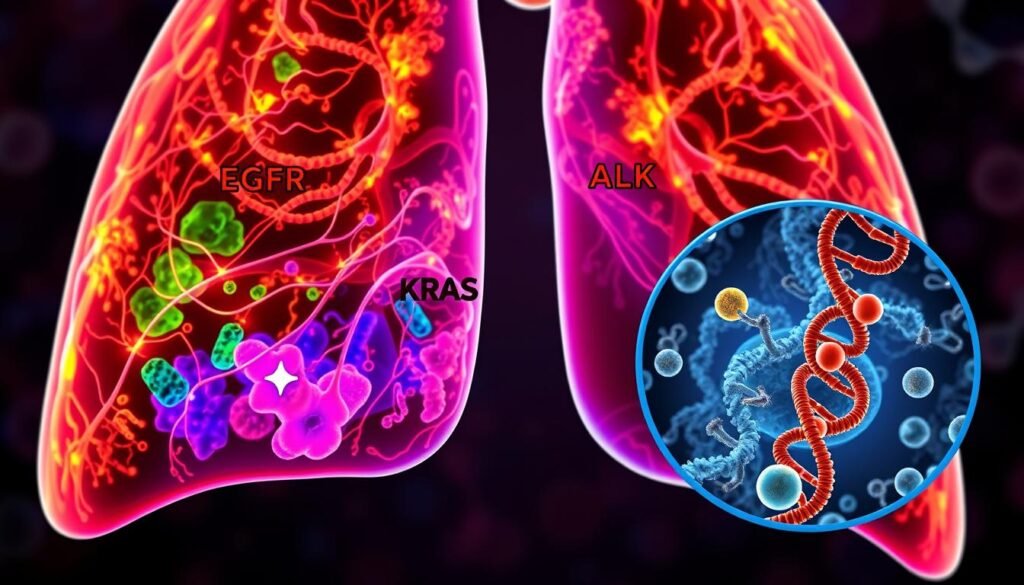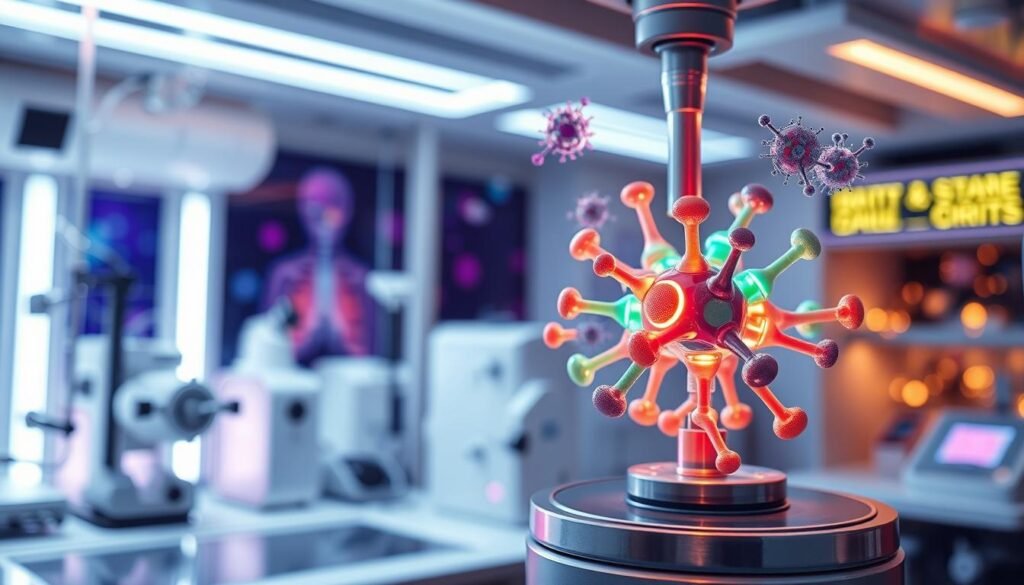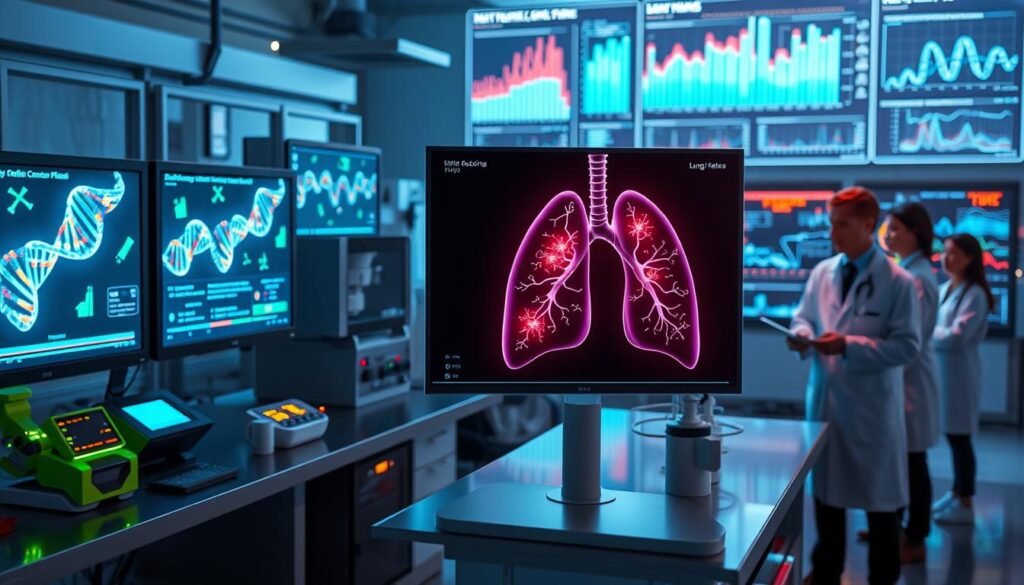Up to 30% of non-small cell lung cancer (NSCLC) patients carry mutations in the KRAS gene. This makes KRAS the most found driver mutation in lung cancer. These mutations are key in how the disease gets worse. This is especially true for those with NSCLC, the top cause of death from cancer worldwide. Knowing about these mutations is crucial. They help doctors pick the right treatments for each person.
There are now over fifteen FDA-approved treatments that target specific mutations in NSCLC. This shows how important it is to test for these mutations. This guide helps you understand the importance of driver mutations. It talks about their types and what they mean for targeted treatment.
Key Takeaways
- KRAS mutations are the most prevalent driver mutations in lung cancer patients.
- Over fifteen FDA-approved targeted agents exist for treating lung cancer based on identified mutations.
- Understanding driver mutations is critical for personalized treatment strategies in NSCLC.
- Molecular profiling is essential for accurately identifying mutations and informing treatment decisions.
- Targeted therapies can significantly improve outcomes for patients with specific mutations.
Understanding Lung Cancer and Its Types
Lung cancer is a major cause of cancer deaths in the U.S. About 28% of all cancer deaths in 2010 were from lung cancer. It divides mainly into two types: non-small cell lung cancer and small cell lung cancer. Non-small cell lung cancer (NSCLC) makes up 80–85% of lung cancer cases. This group includes adenocarcinoma, squamous cell carcinoma, and other types.
Knowing the lung cancer types is key for choosing the right treatment. Each kind has its own traits and reacts differently to treatments. A special plan is needed for each patient. Meanwhile, small cell lung cancer (SCLC) makes up about 15–20% of cases. It’s known for being very aggressive and getting worse quickly.
Smoking is a major cause of lung cancer, linked to about 80% of deaths. But, lung cancer can also happen in non-smokers. This can be due to genetics or environmental factors. Research into the molecular aspects of lung cancer helps understand the differences in smokers and non-smokers.
For people diagnosed, knowing the specific cancer classifications is crucial. It helps in finding the most effective treatments. For non-small cell lung cancer, testing for certain gene changes is important. It helps find the best targeted treatments, improving chances of success.
| Lung Cancer Type | Percentage of Total Cases | Common Characteristics |
|---|---|---|
| Non-Small Cell Lung Cancer (NSCLC) | 80–85% | Adenocarcinoma, squamous cell carcinoma, large cell carcinoma |
| Small Cell Lung Cancer (SCLC) | 15–20% | Aggressive, rapid progression |
Understanding lung cancer well is crucial in managing it. Spotting it early and figuring out its type affects patient outcomes greatly.
What Are Driver Mutations?
Driver mutations are specific gene mutations that are crucial in starting various cancers, such as lung cancer. They cause cells to grow out of control. While some can be inherited, many develop from environmental factors. These are known as somatic mutations.
It’s vital to identify these mutations for cancer treatment. This leads to targeted therapies. These therapies attack the harmful proteins, offering tailored care. For example, a study showed that 85% of never-smokers with lung adenocarcinoma had a treatable driver mutation. But, only 65% of smokers had a mutation, and even fewer were treatable (source).
About 95% of never-smokers had driver mutations when fully tested; 78% were treatable. Smokers had less, with only 75% having mutations and 47% treatable. This shows how these mutations impact cancer treatment. As we learn more about these mutations, cancer care gets better and more personal.
Driver Mutations in Lung Cancer
Finding driver mutations in lung cancer is key. They highlight markers that guide treatment choices. Tailored treatments are possible based on the mutations found in tumors. Driver mutations also help predict how a disease might progress. They indicate how well patients will react to certain treatments. Patients with these mutations often do better with targeted therapy than with traditional chemotherapy.
Significance of Driver Mutations
Driver mutations are crucial for cancer growth. They change genes, disrupting normal cell signaling. This leads to uncontrollable cell division, causing cancer to start. Over time, more genetic changes make the cancer worse. This increases its ability to spread and harm.
How Driver Mutations Lead to Cancer Development
It’s vital to understand how driver mutations work. This knowledge helps create personalized treatments. These mutations cause cells to grow too much, ignoring normal controls. Researchers are working to find treatments that target these specific mutations. This could change how lung cancer is treated, making therapies more effective for each patient.
Common Driver Mutations Found in Lung Cancer
Learning about common mutations in lung cancer tells us a lot about treatment options. These driver mutations play a big role in how doctors plan care and what they expect for patients. Let’s go through the main mutations found in lung cancer.
EGFR Mutations and Their Impact
EGFR mutations are quite common in a type of lung cancer called non-small cell lung cancer (NSCLC). They happen in parts of the gene that affect cell growth, leading to faster spreading of cancer. Mutations like L858R and deletions in exon 19 change how patients react to treatment. Medicines targeting these mutations bring great results, helping many people.
ALK Rearrangements in Non-Small Cell Lung Cancer
About 7% of lung cancers have ALK rearrangements, especially seen in adenocarcinomas. These changes in genes respond well to certain drugs, with crizotinib being an important one. Spotting ALK rearrangements helps doctors choose the best treatment, improving chances of getting better.
Insights into KRAS Mutations
KRAS mutations mark about 25-30% of NSCLC cases. They mess up the normal signaling in cells, causing them to grow uncontrollably. Now, we have new medicines like sotorasib and adagrasib targeting KRAS G12C mutations. This shows progress in how we can treat lung cancer.
Other Notable Mutations: BRAF, ROS1, and MET
Besides EGFR, ALK, and KRAS, other mutations like BRAF, ROS1, and MET exon 14 skipping also matter in lung cancer. BRAF mutations respond to specific inhibitors. Even though ROS1 changes are rare, they react to crizotinib, which is key to choosing treatments. MET exon 14 skipping also points to a specific approach, showing the diversity of lung cancer mutations.
| Mutation Type | Prevalence | Targeted Therapy |
|---|---|---|
| EGFR | ~12% (higher in Asians) | EGFR TKIs (e.g., osimertinib) |
| ALK | ~7% | Crizotinib |
| KRAS | ~25-30% | Sotorasib, adagrasib |
| BRAF | Varies | BRAF inhibitors |
| ROS1 | ~1% | Crizotinib |
| MET | Commonly altered | MET inhibitors |

The Role of Molecular Profiling in Identifying Driver Mutations
Molecular profiling is key to understanding lung cancer. It gives a clear picture of tumor genes. This helps identify driver mutations important for effective treatment. With modern methods, doctors provide personalized care based on tumor genetics.
What is Molecular Profiling?
Molecular profiling examines tumor genes to find cancer-driving mutations. It uses genetics to categorize tumors, not just their physical traits. This way, doctors can pinpoint each tumor’s unique factors for better treatment.
Techniques Used in Molecular Profiling
Next-generation sequencing (NGS) is a huge leap in molecular profiling. It checks many genes at once for mutations. Other tests like PCR and FISH look at certain genes. Together, these methods offer deep insights into lung cancer genetics.
Benefits of Molecular Profiling in Lung Cancer Treatment
Molecular profiling brings many benefits to lung cancer care. It finds key mutations in many cases, leading to focused treatment. Drugs like crizotinib help patients with specific genetic changes live longer. Molecular profiling also guides the use of immunotherapy by examining the tumor’s genetics.
Molecular profiling offers better patient care through targeted treatments. In lung cancer, with its genetic diversity, personalized approaches are crucial. This leads to better decisions and treatments for patients.
| Mutation Type | Percentage of Cases | Treatment Response |
|---|---|---|
| EGFR activating mutations | 27-62% (East Asian NSCLC) | Increased sensitivity to EGFR TKIs |
| ALK rearrangements | Rare but actionable | Crizotinib associated with prolonged survival |
| KRAS mutations | 25-50% (Caucasian NSCLC) | Novel targeted therapies under investigation |
| PD-L1 expression | 32.5% (≥1% cancer cells) | Guides immunotherapy decisions |
Targeted Therapy: Revolutionizing Lung Cancer Treatment
Targeted therapy has changed lung cancer care by focusing on certain gene changes in cancer cells. This cancer treatment uses drugs to block proteins made by gene changes. This can work better than old treatments. By hitting specific cell pathways, side effects are less and results can be better.
How Targeted Therapy Works
Targeted therapy stops specific drug mechanisms that make cancer grow. It can pinpoint genetic changes like EGFR mutations and ALK rearrangements. This makes treatment plans more precise. This approach is especially good for non-small cell lung cancer (NSCLC), most lung cancers in the West.
Overview of FDA-Approved Targeted Agents
The U.S. FDA has okayed many targeted drugs for different gene changes, including:
| Targeted Agent | Mutation | Indication |
|---|---|---|
| Gefitinib | EGFR | First-line treatment for EGFR mutant NSCLC |
| Erlotinib | EGFR | Pre-treatment for advanced NSCLC |
| Crizotinib | ALK | Advanced ALK-positive NSCLC |
| Alectinib | ALK | First-line treatment for ALK-positive NSCLC |
| Sotorasib | KRAS G12C | Treatment for KRAS G12C mutant NSCLC |
These FDA-approved drugs show great progress in therapy. They are key in making treatment better for patients.
Challenges in Targeted Therapy
Still, targeted therapy has its hurdles, like developing resistance. Patients might stop responding to treatment. Research is trying to understand and beat this issue. Innovating new drugs is important to stay ahead of the cancer.

Learn more about the impact of targeted therapies in lung cancer at this resource.
Resistance Mechanisms in Lung Cancer Treatment
Lung cancer treatment faces many challenges. This is mainly because of how tumors resist therapy. Knowing how these resistance mechanisms work is key to better treatments and outcomes. There are two main types of resistance: acquired and intrinsic. Understanding these helps us fight lung cancer more effectively.
Understanding Acquired Resistance
Acquired resistance happens as cancer cells evolve. They change over time, which can make treatments fail. This is often due to mutation changes in the tumor cells. For example, in EGFR-mutant non-small cell lung cancer (NSCLC), a new mutation called T790M might appear. This makes first-generation tyrosine kinase inhibitors (TKIs) less effective. Delving into acquired resistance helps scientists find new ways, like advanced TKIs and combination treatments. These new strategies aim to beat the resistant cancer cells.
Intrinsic Resistance Factors
Intrinsic resistance means some cancer cells are already tough against treatments from the start. This resistance might come from certain genetic factors. These can be mutations present at diagnosis or aspects of the tumor’s environment that keep cells alive even when faced with targeted therapies. Changes in genes related to epithelial-to-mesenchymal transition (EMT), for instance, can lead to resistance against primary TKI treatments. Spotting these inherent resistance mechanisms is crucial. It helps in crafting targeted approaches to overcome the challenges in lung cancer therapy.
| Resistance Type | Description | Examples |
|---|---|---|
| Acquired Resistance | Develops over time as cancer cells adapt to therapy | EGFR T790M mutation, secondary mutations |
| Intrinsic Resistance | Present from diagnosis; cancer cells inherently resist treatment | EMT-related gene alterations, pre-existing mutations |
Personalized Approach to Lung Cancer Treatment
Personalized medicine is changing how we tackle lung cancer, especially non-small cell lung cancer (NSCLC). Through individual mutation profiling, doctors can create patient-specific treatment plans. These plans use a person’s genetic details to guide therapy. Key mutations like EGFR, KRAS, and ALK are crucial for targeted treatments, making them more effective.
The Importance of Individual Mutation Profiling
Understanding a patient’s genetic mutations allows for tailored treatments. This means therapies match the unique traits of each tumor. For example, certain genetic changes mean some patients do better with certain drugs. This increases chances of remission and survival. Mutation profiling is vital for discovering the best treatment paths, making personalized therapy more effective.
Future Directions in Personalized Medicine
The future of medicine looks bright, with big steps forward in cancer treatment expected. Research aims to create larger mutation panels to offer more therapy options. This growth in targeted therapies and better treatment matching will improve lung cancer management.

| Mutation Type | Response Rate | Associated Resistance |
|---|---|---|
| MET Amplification | 30% (osimertinib-resistant) | 5-10% (first-generation TKI-resistant) |
| HER2 Amplification | Not specified | Up to 13% of EGFR TKI resistance |
| PI3K Mutations | Not specified | Approximately 4% in resistant specimens |
| Afatinib + Cetuximab | 29% overall response | EGFR-mutant TKI-resistant NSCLC |
This approach is more than a scientific breakthrough. It also makes patients happier and treatments more effective in fighting lung cancer.
Research and Future Perspectives on Driver Mutations
Recent developments in lung cancer research promise a bright future for patients. Scientists are making strides in understanding driver mutations. This knowledge is boosting the creation of targeted therapies. By focusing on mutation-specific treatments and new strategies in clinical trials, we are seeing incredible progress.
Recent Advances in Lung Cancer Research
Experts are pinpointing mutations that make lung cancer so deadly. They are now using circulating tumor DNA (ctDNA) for genetic testing. This approach is more sensitive than using circulating tumor cells (CTCs). It allows for fast and right-on-target mutation detection without invasive procedures.
Emerging Therapies for Targeting Mutations
New treatments are changing lung cancer care. Researchers are testing novel KRAS inhibitors and combined treatments in studies. These aim to overcome resistance that often starts one to two years after beginning targeted treatments. By studying mutations closely, we can create personalized plans for patients.
| Aspect | Details |
|---|---|
| Advancements | Development of novel KRAS inhibitors and combinatorial treatment strategies |
| Detecting Mutations | Utilization of ctDNA for non-invasive genetic analysis |
| Clinical Trials | Focus on addressing resistance in targeted therapies |
| Future Directions | Enhancing options for diverse mutation profiles in lung cancer patients |
Conclusion
Knowing about driver mutations in lung cancer is very important. It shapes how doctors treat the disease and helps patients. Studies show that lung adenocarcinoma patients have different genetic changes based on if they smoked or not. People who never smoked often have mutations like EGFR and ALK. But those who used to smoke or still do have more KRAS mutations. This shows that lung cancer varies a lot, needing treatments that fit each person.
Personalized medicine is becoming crucial in lung cancer care. More studies link certain mutations to how the disease acts in the body. This knowledge lets doctors pick the best treatments. It leads to better outcomes for patients. A lot of this info comes from deep research, like what you can find here. This research leads to new ways to treat lung cancer based on each person’s genes.
The fight against lung cancer needs constant research and learning. Knowing more about driver mutations helps a lot. As there are more treatment options and new methods are found, there’s hope for patients. Understanding these mutations helps doctors and patients deal with lung cancer better. The future looks brighter for those facing this tough disease.